
Sir Michael John Gambon was an Irish-English actor. Gambon started his acting career with Laurence Olivier as one of the original members of the Royal National Theatre. Over his six-decade-long career, he received three Olivier Awards and four BAFTA TV Awards. In 1998, he was knighted by Queen Elizabeth II for services to drama.

Blithe Spirit is a comic play by Noël Coward, described by the author as "an improbable farce in three acts". The play concerns the socialite and novelist Charles Condomine, who invites the eccentric medium and clairvoyant Madame Arcati to his house to conduct a séance, hoping to gather material for his next book. The scheme backfires when he is haunted by the ghost of his wilful and temperamental first wife, Elvira, after the séance. Elvira makes continual attempts to disrupt Charles's marriage to his second wife, Ruth, who cannot see or hear the ghost.

The Noël Coward Theatre, formerly known as the Albery Theatre, is a West End theatre in St. Martin's Lane in the City of Westminster, London. It opened on 12 March 1903 as the New Theatre and was built by Sir Charles Wyndham behind Wyndham's Theatre which was completed in 1899. The building was designed by the architect W. G. R. Sprague with an exterior in the classical style and an interior in the Rococo style.
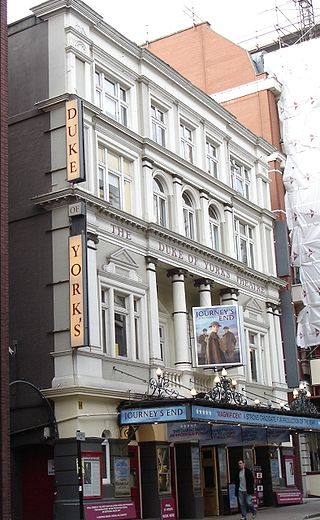
The Duke of York's Theatre is a West End theatre in St Martin's Lane, in the City of Westminster, London. It was built for Frank Wyatt and his wife, Violet Melnotte, who retained ownership of the theatre until her death in 1935. Designed by the architect Walter Emden, it opened on 10 September 1892 as the Trafalgar Square Theatre, and was renamed Trafalgar Theatre in 1894. The following year, it became the Duke of York's to honour the future King George V.

The Gielgud Theatre is a West End theatre, located on Shaftesbury Avenue, at the corner of Rupert Street, in the City of Westminster, London. The house currently has 986 seats on three levels.

The Theatre Royal Haymarket is a West End theatre on Haymarket in the City of Westminster which dates back to 1720, making it the third-oldest London playhouse still in use. Samuel Foote acquired the lease in 1747, and in 1766 he gained a royal patent to play legitimate drama in the summer months. The original building was a little further north in the same street. It has been at its current location since 1821, when it was redesigned by John Nash. It is a Grade I listed building, with a seating capacity of 888. The freehold of the theatre is owned by the Crown Estate.
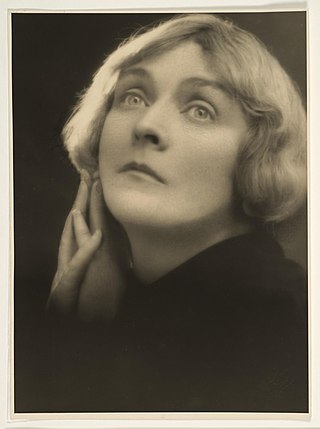
Dame Agnes Sybil Thorndike, Lady Casson, was an English actress whose stage career lasted from 1904 to 1969.
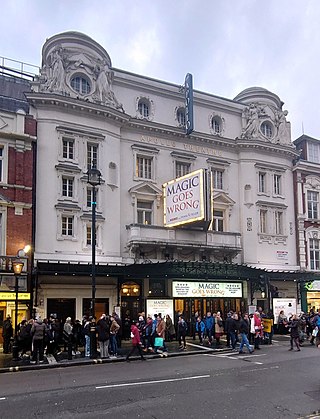
The Apollo Theatre is a Grade II listed West End theatre on Shaftesbury Avenue in the City of Westminster, in central London. Designed by the architect Lewin Sharp for owner Henry Lowenfeld, it became the fourth legitimate theatre to be constructed on the street when it opened its doors on 21 February 1901, with the American musical comedy The Belle of Bohemia.

The Corn Is Green is a 1938 semi-autobiographical play by Welsh dramatist and actor Emlyn Williams. The play premiered in London at the Duchess Theatre in September 1938; with Sybil Thorndike as Miss Moffat and Williams himself portraying Morgan Evans, the West End production ran in all for 600 performances. The original Broadway production starred Ethel Barrymore and premiered at the National Theatre in November 1940, running for 477 performances.

Sir Lewis Thomas Casson MC was an English actor and theatre director, and the husband of actress Dame Sybil Thorndike.

The Vaudeville Theatre is a West End theatre on the Strand in the City of Westminster. As the name suggests, the theatre held mostly vaudeville shows and musical revues in its early days. It opened in 1870 and was rebuilt twice, although each new building retained elements of the previous structure. The current building opened in 1926, and the capacity is now 690 seats. Rare thunder drum and lightning sheets, together with other early stage mechanisms, survive in the theatre.
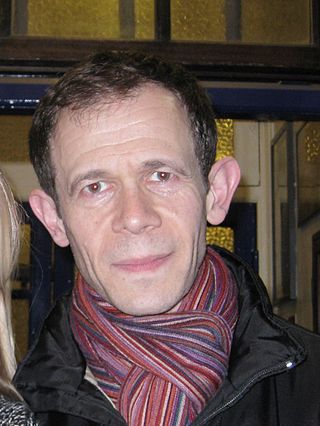
Adam N. Godley is an English-American actor. He has been nominated for two Tony Awards and four Laurence Olivier Awards for his performances on the New York and London stages, including Private Lives in 2001, The Pillowman in 2002, Anything Goes in 2011, and The Lehman Trilogy in 2019. He made his Broadway debut in 2002 in a revival of Noël Coward's Private Lives for which he earned a Theatre World Award for Outstanding Broadway debut. In 2011, he returned to Broadway in the musical Anything Goes for which he earned a Tony Award for Best Featured Actor in a Musical nomination. In 2021, The Lehman Trilogy made its Broadway transfer to great critical acclaim, and securing Godley another Tony nomination for Best Actor in a Play.

Dulcie Winifred Catherine Savage Denison,, known professionally as Dulcie Gray, was a British actress, mystery writer and lepidopterist.

The Piccadilly Theatre is a West End theatre located at the junction of Denman Street and Sherwood Street, near Piccadilly Circus, in the City of Westminster, London. It opened in 1928.

The Lyric Theatre is a West End theatre in Shaftesbury Avenue in the City of Westminster. It was built for the producer Henry Leslie, who financed it from the profits of the light opera hit, Dorothy, which he transferred from its original venue to open the new theatre on 17 December 1888.
Janie Dee is a British actress. She won the Olivier Award for Best Actress, Evening Standard Award and Critics' Circle Theatre Award for Best Actress in a Play, and in New York the Obie and Theatre World Award for Best Newcomer, for her performance as Jacie Triplethree in Alan Ayckbourn's Comic Potential.
Lia Williams is an English actress and director, both on stage, in film and television. Her roles have included playing Wallis Simpson in The Crown, May 33rd for which she was nominated for a BAFTA, The Missing (2016), Kiri (2016), His Dark Materials (2019-2022), and The Capture (2016-present).
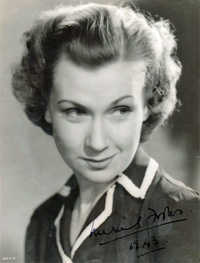
Meriel Forbes, Lady Richardson was an English actress. She was a granddaughter of Norman Forbes-Robertson and great-niece of Sir Johnston Forbes-Robertson. After making her stage debut with her father's touring company in 1929 she progressed via provincial repertory to the West End, where she appeared continually from the 1930s to the 1970s.

The Harold Pinter Theatre, known as the Comedy Theatre until 2011, is a West End theatre, and opened on Panton Street in the City of Westminster, on 15 October 1881, as the Royal Comedy Theatre. It was designed by Thomas Verity and built in just six months in painted (stucco) stone and brick. By 1884 it was known as simply the Comedy Theatre. In the mid-1950s the theatre underwent major reconstruction and re-opened in December 1955; the auditorium remains essentially that of 1881, with three tiers of horseshoe-shaped balconies.


















